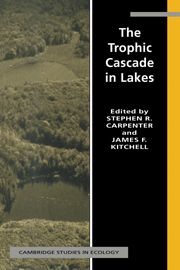Book contents
- Frontmatter
- Contents
- Contributors
- Preface
- 1 Cascading trophic interactions
- 2 Experimental lakes, manipulations and measurements
- 3 Statistical analysis of the ecosystem experiments
- 4 The fish populations
- 5 Fish behavioral and community responses to manipulation
- 6 Roles of fish predation: piscivory and planktivory
- 7 Dynamics of the phantom midge: implications for zooplankton
- 8 Zooplankton community dynamics
- 9 Effects of predators and food supply on diel vertical migration of Daphnia
- 10 Zooplankton biomass and body size
- 11 Phytoplankton community dynamics
- 12 Metalimnetic phytoplankton dynamics
- 13 Primary production and its interactions with nutrients and light transmission
- 14 Heterotrophic microbial processes
- 15 Annual fossil records of food-web manipulation
- 16 Simulation models of the trophic cascade: predictions and evaluations
- 17 Synthesis and new directions
- References
- Index
2 - Experimental lakes, manipulations and measurements
Published online by Cambridge University Press: 06 August 2010
- Frontmatter
- Contents
- Contributors
- Preface
- 1 Cascading trophic interactions
- 2 Experimental lakes, manipulations and measurements
- 3 Statistical analysis of the ecosystem experiments
- 4 The fish populations
- 5 Fish behavioral and community responses to manipulation
- 6 Roles of fish predation: piscivory and planktivory
- 7 Dynamics of the phantom midge: implications for zooplankton
- 8 Zooplankton community dynamics
- 9 Effects of predators and food supply on diel vertical migration of Daphnia
- 10 Zooplankton biomass and body size
- 11 Phytoplankton community dynamics
- 12 Metalimnetic phytoplankton dynamics
- 13 Primary production and its interactions with nutrients and light transmission
- 14 Heterotrophic microbial processes
- 15 Annual fossil records of food-web manipulation
- 16 Simulation models of the trophic cascade: predictions and evaluations
- 17 Synthesis and new directions
- References
- Index
Summary
The experimental lakes
Our studies were conducted in Paul, Peter, and Tuesday Lakes (Fig. 2.1). These lakes lie on the grounds of the University of Notre Dame Environmental Research Center (UNDERC) near Land o' Lakes, Wisconsin, U.S.A. (89°32′ W, 46°13′N). UNDERC occupies more than 2800 ha of land donated to the University of Notre Dame in the 1940s ‘for the scientific purposes of Forestry, Botany, Biology and allied sciences’ (Gillen, 1939). The limnological potential of the property had been recognized in the 1920s, when E. A. Birge, C. Juday and associates sampled most of its lakes (Beckel, 1987).
Because the UNDERC facility is privately owned and protected, it offers remarkable opportunities for field experimentation. Fish populations in the experimental lakes are unexploited, and can be manipulated without the complications of sport or commercial fishing. The drainage basins are undeveloped and lie entirely within the UNDERC property, so disturbances or chemical inputs to the lakes that might confound ecosystem experiments are minimized. UNDERC is about 40 km from the University of Wisconsin's Trout Lake Station, a national center of limnological activity for more than 50 years (Magnuson & Bowser, 1990). The array of intensively studied lakes in the region provides additional reference (or ‘control’) systems for manipulative experiments (Carpenter et al., 1989) as well as opportunities for comparative studies (Carpenters et al., 1991).
- Type
- Chapter
- Information
- The Trophic Cascade in Lakes , pp. 15 - 25Publisher: Cambridge University PressPrint publication year: 1993
- 3
- Cited by



